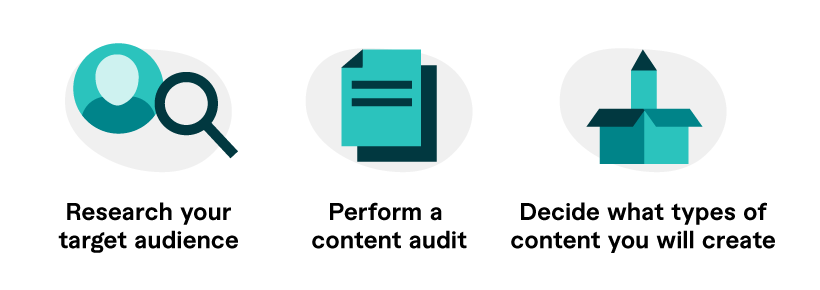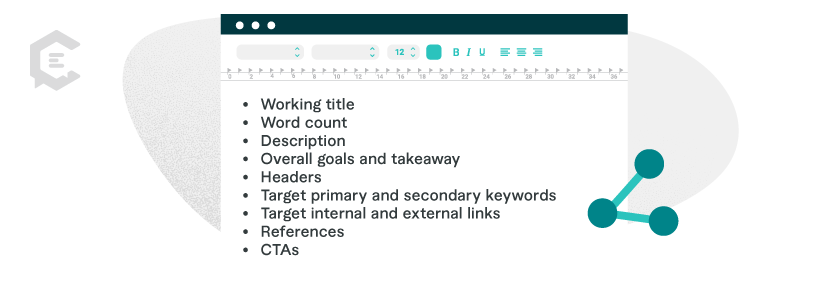We’ll admit it – we’re obsessed with crafting great content that helps drive your business. But before we start our content creation, we always insist on having a clear and effective content marketing strategy.
And here’s the thing — we’ve talked to thousands of marketers over the past decade. A lot of them don’t have a documented content strategy. If that’s surprising to you, the stats back it up. In a recent study, only 57 percent of marketers said they have a documented strategy. And only 19 percent of those said their strategy was “advanced.”
That means there’s a lot of room to get an edge over the competition.
In this article, we’ll walk you through a step-by-step guide to help you create, measure, and sustain a successful content marketing strategy.
But before we proceed, remember one thing — content marketing is a long-term and ongoing strategy. Meaningful results require thoughtful research, a fierce commitment to quality, and consistency.
Let’s build your foundation.
Get started building your content blueprint with our downloadable workbook today! Complete the workbook easily alongside this article for an immersive experience building your content strategy.
Your Content Marketing Strategy Blueprint
1. Start with research
The first step to creating a winning content marketing strategy begins with a deep dive into research, focusing on identifying and clarifying your brand goals. It’s important to recognize that SMB and enterprise businesses often have different starting points and objectives for their content strategies.
Here’s a closer look at some common goals most marketers aim for when crafting a content strategy:
- Revenue
- Lead generation
- Brand awareness
- User engagement
- Inbound links
- Conversions
- Traffic
- Customer loyalty
- Domain authority
Each of these goals requires a specific approach to content creation and distribution. The key is understanding your audience’s unique needs and tailoring your content strategy accordingly.
- Research your target audience. Analyze your website and social media analytics to build your personas based on the data. (If you need to create a persona, HubSpot has a great Make My Persona Tool to get you started.)
- Perform a content audit. Audits check what content you have published, how it performs, and any issues affecting its efficacy and user experience (UX). If you’re unsure how to perform a content audit, we have a step-by-step guide to help.
- Decide what types of content you will create. Content is created in many different ways. From articles and podcasts to infographics and white papers, there are dozens of content types marketers use to reach their target audiences. We’ve identified the top 25 content types you can use in your content marketing strategy.
Executing all of these steps will set the foundation for the rest of your strategy.
2. Ideate your content
Next, you’re beginning your ideation process. The core of this step revolves around a deep understanding of your audience’s needs and interests. Good thing we already did our research in the step above!
Start with reviewing those audience needs because it’s not just about creating content. It’s about providing people with content that resonates, engages, and adds value relevant to their needs.
Ask yourself: What kind of content can you create to best serve your audience? What will not only capture their attention but also provide value? More importantly, what can help solve their problem?
The most effective content ideation starts and ends with targeting your audience’s needs, pain points, and interests. The more closely your content aligns with what your audience cares about, the more likely they are to share it and enhance your brand awareness.
If you’re unsure how to start, we’ve got you covered with a checklist below so you can create a powerhouse of topics to get your content marketing strategy off the ground.
To get you started:
- Use our Ultimate Content Marketing Ideation Guide: Techniques, Tips, & Tools workbook to ideate topics and ideas
- Use AnswerThePublic to look for questions your target audience asks in your niche
- Check Google’s autocomplete suggestions for topic ideas
- Look at “People Also Ask” search engine results for questions you can answer
- Visit your top competitors’ websites and look at what content they are creating
- Consider investing in a premium tool like Ahrefs and Semrush for content research
Tip: Read our Ultimate Guide to Content Creation for detailed steps on content ideation.
3. Build a content spreadsheet
As marketers, we all know ideating can be a little messy. It’s essential to systematically organize all those ideas to manage and visualize your content plan.
Thank god for spreadsheets.
Within your spreadsheet, add in topics you ideated from step 2 and create your table. For this example, we’re using “The Ultimate SEO Guide.” (You can build a spreadsheet using the example we provided below).
Fill out all the information in your spreadsheet; feel free to expand your spreadsheet to fit your content goals and make notes as needed.
And don’t forget to make your spreadsheet shareable for the stakeholders involved.
4. Create detailed content briefs
Detailed content briefs are the blueprints that help your writers and content creators produce content that aligns with your strategy and meets your objectives. They should outline as much information as possible to set your creators up for success.
In your Word document, create a shared document using the following requirements:
- Working title
- Word count
- Description
- Overall goals and takeaway
- Headers
- Target primary and secondary keywords
- Target internal and external links
- References
- CTAs
After completing each brief:
- Paste the link into its corresponding “content brief” column in the spreadsheet you created in step 3
- Continue this process until you have a healthy amount of content that needs to be created
- Keep in mind your spreadsheet will change over time as you develop your content strategy
- Create, publish, distribute, and measure results
Now that you’ve put the work into building a foundation for your content. It’s time to start creating and publishing your content. Use the spreadsheet as a guide for distributing your content. Create a column that helps you track whether the piece has been completed to ensure nothing falls through the cracks. Continue to optimize your content for each marketing channel and target audience as you measure your KPIs to maximize impact.
Track your content’s performance:
- How well did it perform?
- Did it meet its expected goals?
- What worked and what didn’t work?
- Can the piece be reoptimized?
Remember, content strategy isn’t static. It’s a continuous cycle of creation, measurement, learning, and adaptation. As you gather insights on your content’s performance, use it to evolve your strategy and refine your marketing goals.
The best content strategy is an adaptive strategy that keeps your content effectively engaging your audience while achieving your marketing goals.
Congratulations, you did it!
You’ve established the foundation of your content marketing strategy!
Now, you can track your content ideation, development, and optimization efforts. But it doesn’t stop there. Remember, it takes months of consistent content marketing to get winning results. It’s a marathon, not a sprint.
Get started building your content blueprint with our downloadable workbook today!
Great Content Demands Great Talent
When creating truly great content, you need the right talent to bring your ideas and strategies to life. That’s why our freelance community is at the heart of our service.
We have 4,000+ creators specializing in 200+ business categories, so you get the talent you need to create your desired content. Each member is carefully selected and vetted by our Talent Managers.
When you work with us, we match you with the perfect creators for your project’s unique needs and budget. Talk to a content specialist today to see how we can help you propel your brand’s growth and success.








